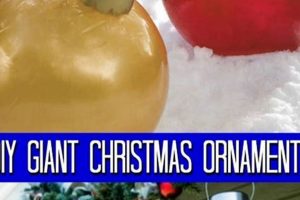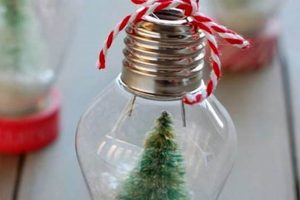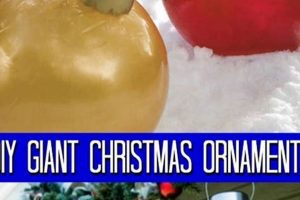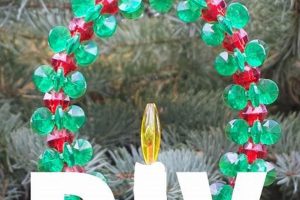Handcrafted decorations created from felt material, designed for personal assembly, represent a creative and accessible avenue for seasonal embellishments. These items frequently involve pre-cut felt shapes, adhesive components, and illustrative instructions, enabling individuals to produce personalized festive adornments for trees, garlands, or gift accents. A simple example is a felt star, assembled from two star-shaped felt pieces, stitched together with embroidery floss, and stuffed with a small amount of fiberfill.
The practice of creating customized decorations offers several benefits, ranging from economic advantages to enhanced personal expression. Such activities can reduce the financial burden associated with purchasing ready-made ornaments while fostering a sense of accomplishment. Historically, the making of homemade decorations reflects a tradition of resourcefulness, particularly during periods where commercially produced goods were scarce or unaffordable. It also allows individuals to imbue their celebrations with unique and personalized touches, reflecting their specific aesthetic preferences or cultural heritage.
The subsequent sections will delve into diverse design possibilities using this medium, exploring techniques for crafting intricate patterns, selecting appropriate materials, and ensuring durability in the finished product. Detailed instructions and creative inspiration will be provided to guide individuals through the process of developing unique and memorable holiday decorations.
Crafting Durable and Appealing Felt Adornments
The following guidelines aim to enhance the quality and longevity of handcrafted festive decorations, ensuring they remain cherished items for years to come.
Tip 1: Selection of High-Quality Felt: Opt for felt crafted from wool or wool blends. These materials exhibit superior durability and resistance to pilling compared to synthetic alternatives. Example: Using merino wool felt for intricate details will maintain its shape and texture longer than acrylic felt.
Tip 2: Precision in Cutting: Employ sharp scissors or rotary cutters to achieve clean, accurate edges on felt pieces. This prevents fraying and ensures a professional appearance. Example: Use a rotary cutter with a sharp blade and a cutting mat to cut multiple layers of felt with precision.
Tip 3: Strategic Adhesion Techniques: Utilize fabric glue specifically formulated for felt. Apply adhesive sparingly and evenly to avoid seepage and maintain the texture of the felt. Example: Apply a thin bead of fabric glue along the edge of felt pieces and press together firmly, using pins to secure until dry.
Tip 4: Reinforcement Stitching: Implement hand-stitching along seams and edges to provide additional structural support. Blanket stitch or whip stitch are particularly effective for securing felt layers. Example: Use a blanket stitch along the perimeter of a felt ornament to reinforce the edges and add a decorative element.
Tip 5: Embellishment Security: When attaching beads, sequins, or other embellishments, utilize strong thread and secure each item with multiple stitches. This prevents detachment and potential choking hazards. Example: Secure beads with multiple backstitches to prevent them from loosening or falling off.
Tip 6: Sturdy Hanging Loops: Affix hanging loops securely using reinforced stitching or robust adhesive. Ensure the loop is capable of supporting the weight of the finished decoration. Example: Create a hanging loop using embroidery floss and attach it to the top of the ornament using a reinforced blanket stitch.
Tip 7: Proper Storage: Store finished items in a dry, dust-free environment to prevent damage from moisture or pests. Use acid-free tissue paper to separate items and prevent color transfer. Example: Store finished ornaments in a plastic container with a lid, layered with acid-free tissue paper.
By adhering to these recommendations, individuals can significantly improve the overall quality and longevity of crafted decorations, creating treasured keepsakes that can be enjoyed for generations.
The subsequent sections will explore the creative possibilities in designs, providing individuals with guidance to create unique and memorable holiday decorations.
1. Material Quality
Material quality is a foundational determinant of the final aesthetic appeal, longevity, and overall perceived value of handcrafted felt decorations. The selection of superior materials significantly impacts the durability and visual characteristics of these decorative items.
- Fiber Composition
The composition of the felt fiberswhether natural (wool, merino) or synthetic (acrylic, rayon)directly influences the material’s resilience, texture, and susceptibility to wear. Natural fibers generally offer superior durability and resistance to pilling, maintaining a polished appearance over time. For example, using 100% wool felt results in a finished product that can withstand handling and storage better than decorations constructed from acrylic felt, which tends to stretch and lose shape.
- Density and Thickness
Felt density dictates its structural integrity and ability to hold its shape when cut, stitched, or embellished. Denser felt resists stretching and distortion, providing a stable base for intricate designs. Thicker felt materials offer increased dimension and perceived quality but may require more specialized tools for cutting and sewing. An example of this could be selecting a thick felt material for an intricate pattern design to ensure a long lasting item.
- Colorfastness
The degree to which a felt material retains its color vibrancy after exposure to light, washing, or other environmental factors is a critical consideration. High-quality felt exhibits superior colorfastness, ensuring that the decoration maintains its original appearance over extended periods. Conversely, low-quality felt may fade or bleed when exposed to moisture or sunlight, diminishing its aesthetic appeal. Decorations intended for outdoor use or bright areas require high-quality colored material.
- Texture and Finish
The surface texture and finish of the felt contribute significantly to the visual and tactile experience of the finished decoration. Smooth, consistent textures create a refined appearance, while variations in texture can add visual interest and depth. High-quality felt materials often undergo processes to enhance their surface finish, improving their resistance to pilling and improving visual appeal.
In conclusion, careful consideration of fiber composition, density, colorfastness, texture, and finish are vital to the production of high-quality decorations. The use of premium felt materials enhances the decoration’s longevity and visual appeal, ensuring that each item becomes a cherished keepsake for years to come. A superior material helps to avoid color fading and durability issues.
2. Cutting Precision
Accurate cutting constitutes a fundamental element in the successful creation of handcrafted festive decorations. The precision with which felt components are cut directly impacts the overall aesthetic appeal, structural integrity, and perceived quality of the final product.
- Edge Definition and Clarity
Precisely cut felt pieces exhibit clean, well-defined edges, contributing to a professional and polished appearance. Inaccurate cuts, conversely, result in ragged or uneven edges, detracting from the item’s visual appeal. For example, a felt snowflake with sharp, clean points will appear more refined than one with rounded or frayed edges. The former showcases superior craftsmanship and attention to detail.
- Seam Alignment and Integrity
Accurate cutting ensures that felt components align correctly during the assembly process. This alignment is essential for creating secure and visually appealing seams. Mismatched edges due to imprecise cutting can lead to weak seams and a distorted final product. Imagine assembling a felt animal shape where the component parts don’t perfectly align, leading to an uneven, less-than-ideal result.
- Intricate Detail Execution
Designs incorporating intricate details, such as fine lines, curves, or complex shapes, demand a high degree of cutting precision. Inability to accurately execute these details results in a loss of visual complexity and diminishes the overall impact of the decoration. Consider, for example, a felt ornament depicting a filigree pattern; imprecise cuts compromise the delicate nature of the design.
- Material Efficiency and Waste Reduction
Precise cutting techniques minimize material waste and optimize the utilization of felt fabric. Efficient cutting patterns reduce the amount of scrap material generated during the production process, leading to cost savings and environmentally responsible crafting practices. Efficient cutting maximizes material use, reducing the overall cost of a given item.
In conclusion, cutting precision plays a critical role in the quality and visual appeal of handcrafted felt decorations. Accurate cuts contribute to clean edges, secure seams, intricate detail execution, and material efficiency. Employing sharp tools and careful cutting techniques ensures a finished product that reflects craftsmanship and attention to detail, enhancing its value as a treasured keepsake.
3. Adhesive Strength
Adhesive strength is a critical parameter affecting the durability and structural integrity of handcrafted festive decorations. The capacity of an adhesive to maintain its bond under varying conditions directly influences the longevity and overall quality of finished decorations.
- Initial Bond Formation
The initial bond strength of an adhesive dictates how quickly and effectively it adheres felt components upon application. A robust initial bond minimizes the need for prolonged clamping or pinning during assembly, accelerating the crafting process. Inadequate initial adhesion results in shifting components, misaligned seams, and ultimately, a structurally unsound decoration. For instance, a quick-drying adhesive with strong initial tack is beneficial for assembling intricate layered designs, preventing displacement of delicate pieces.
- Resistance to Environmental Stress
Adhesives used in crafting must exhibit resistance to environmental stressors such as temperature fluctuations, humidity, and UV exposure. Degradation of the adhesive bond due to these factors can lead to delamination, weakening the structural integrity of the ornament. Decorations intended for outdoor display or storage in uncontrolled environments require adhesives with enhanced resistance to environmental degradation.
- Long-Term Durability
The long-term durability of the adhesive bond is essential for ensuring that decorations maintain their structural integrity over extended periods. Adhesives prone to embrittlement, cracking, or discoloration negatively impact the appearance and longevity of the finished product. Opting for archival-quality adhesives mitigates the risk of long-term degradation, preserving the aesthetic appeal of the decoration for years to come. For example, using acid-free adhesives can prevent the discoloration of felt over time.
- Compatibility with Felt Materials
Adhesive compatibility with felt materials is a crucial consideration. Certain adhesives may react adversely with specific felt fiber compositions, leading to discoloration, degradation, or weakening of the bond. Selecting adhesives specifically formulated for use with felt ensures optimal adhesion and prevents adverse reactions. Incompatibilities include adhesives that dissolve certain synthetic fibers or leave visible residues on the felt surface.
The selection of adhesives with appropriate strength, environmental resistance, long-term durability, and material compatibility is paramount to producing high-quality handcrafted decorations. Employing the right adhesive not only ensures structural integrity but also contributes to the longevity and overall value of the finished item.
4. Stitching Technique
Stitching technique is intrinsic to the construction and aesthetic of handcrafted felt ornaments. The choice of stitch directly influences structural integrity, seam visibility, and the overall visual appeal of the finished item. Inadequate stitching can compromise the ornament’s durability, leading to seam separation and material distortion. Conversely, skillful application of appropriate stitching methods ensures long-lasting construction and enhances the ornament’s decorative qualities. For instance, a blanket stitch executed with precision not only secures the felt edges but also provides a decorative border. The running stitch offers a straightforward, secure option for joining felt pieces where seam visibility is less critical. Examples, like crafting a felt snowman, demonstrate how effectively using various stitch types helps to construct its key elements for durability and style.
Specific applications of stitching techniques vary depending on the design requirements and intended function of the ornament. Decorative stitches, such as the French knot or chain stitch, can add intricate details and visual interest to felt surfaces. Functional stitches, like the backstitch, provide reinforced seams for areas subject to stress, such as hanging loops. The selection of thread type and color further contributes to the overall aesthetic. Consider a felt star ornament: the edges can be seamlessly joined with an invisible stitch, highlighting the star’s silhouette, or adorned with a contrasting blanket stitch for a bolder design. The integration of these elements is key to creating successful decorations that offer visual and structural integrity.
In summary, mastering diverse stitching techniques is crucial for crafting durable and visually appealing felt ornaments. The selection and execution of appropriate stitches significantly influence the ornament’s longevity and aesthetic value. Challenges in stitching, such as uneven tension or incorrect stitch placement, can detract from the finished product, emphasizing the importance of practice and attention to detail. The relationship between stitching technique and ornament quality demonstrates the significance of craftsmanship in producing items that endure and maintain their aesthetic qualities over time. The use of appropriate stitching methods is a direct reflection of quality, longevity, and craftsmanship.
5. Embellishment Security
The integration of embellishments into handcrafted felt ornaments presents both aesthetic opportunities and challenges regarding structural integrity. The secure attachment of beads, sequins, buttons, and other decorative elements is paramount to ensuring the longevity and safety of the finished product. Inadequate embellishment security can result in detachment, detracting from the ornament’s appearance and potentially creating safety hazards, particularly for ornaments intended for use in households with young children.
- Stitch Integrity and Knot Security
The primary method of securing embellishments involves the use of thread and needle. The selection of a strong, durable thread, such as embroidery floss or quilting thread, is essential. Furthermore, the stitching technique employed must ensure that each embellishment is firmly anchored to the felt substrate. Secure knots, reinforced with fabric glue, prevent unraveling and loosening of the attachment. An example is a sequin attached with multiple backstitches and a surgeon’s knot secured with adhesive.
- Adhesive Selection and Application
Fabric adhesives offer an alternative or supplemental method for securing embellishments. However, the selection of an appropriate adhesive is crucial. The adhesive must be compatible with both the felt and the embellishment materials, exhibiting strong bond strength and resistance to environmental factors such as temperature and humidity. Proper application involves applying a precise amount of adhesive to the embellishment backing, followed by firm and even pressure to ensure proper adhesion. Over-application can result in adhesive seepage, while under-application can lead to premature detachment.
- Material Compatibility and Weight Considerations
The weight and size of embellishments influence the required level of security. Heavier or larger embellishments necessitate more robust attachment methods to prevent detachment under stress. Consideration must also be given to the compatibility of embellishment materials with the felt substrate. Embellishments crafted from materials that are incompatible with the selected adhesive or that are prone to corrosion or degradation can compromise the longevity of the attachment. For example, heavier beads should be stitched onto the felt ornament by sewing machine with a reinforced pattern.
- Testing and Quality Control
Prior to finalizing a handcrafted ornament, it is advisable to conduct thorough testing of embellishment security. This involves subjecting the ornament to moderate stress, such as gentle tugging or shaking, to identify any potential points of weakness. Detached embellishments should be reattached using more robust methods. Implementation of a quality control process, which includes visual inspection of each embellishment attachment, ensures that the finished product meets the required standards of durability and safety.
The interplay between stitching technique, adhesive selection, material compatibility, and quality control measures is critical to maximizing embellishment security in handcrafted felt ornaments. Addressing these factors ensures that the finished product maintains its aesthetic appeal and structural integrity over time, while also mitigating potential safety hazards. The careful consideration of embellishment security elevates the overall quality and value of felt DIY ornaments, transforming them into cherished and enduring keepsakes.
6. Design Complexity
Design complexity in handcrafted felt ornaments directly influences production time, material requirements, and the skill level necessary for successful execution. Ornaments featuring intricate patterns, multiple layers, or a variety of embellishments require more time and resources compared to simpler designs. Increased design intricacy often necessitates specialized tools and techniques, demanding a higher degree of dexterity and experience from the artisan. The causal relationship between design complexity and the overall investment of time and resources is significant. For example, a basic felt star ornament composed of two felt pieces requires minimal effort, whereas a three-dimensional felt reindeer with detailed embroidery and multiple component parts represents a considerably more complex undertaking.
The level of design complexity also dictates the range of potential aesthetic outcomes. While simple designs offer a classic and accessible appeal, complex designs allow for greater artistic expression and personalization. Intricate patterns, varied color palettes, and the incorporation of diverse textures can transform a basic felt ornament into a unique work of art. The practical significance of understanding design complexity lies in the ability to effectively match the ornament design to the available resources, skill level, and desired aesthetic. An artisan with limited experience may opt for a simpler design to ensure a successful outcome, while a more experienced artisan may embrace a complex design to showcase their skills and create a truly distinctive ornament.
In conclusion, design complexity is a critical factor in the creation of handcrafted felt ornaments, influencing both the practical aspects of production and the potential for artistic expression. A balanced understanding of design complexity, combined with a careful assessment of available resources and skill level, is essential for achieving satisfying results. The selection of design, therefore, should consider production feasibility, skill set of artisan, and aesthetic intent, thus ensuring design is tailored to achieve desired outcome.
7. Storage Conditions
Appropriate preservation of handcrafted decorations is crucial for maintaining their aesthetic appeal and structural integrity over extended periods. Environmental factors encountered during storage can significantly impact the condition of felt ornaments, necessitating careful consideration of storage methods.
- Humidity Control
Elevated humidity levels promote the growth of mold and mildew, potentially causing discoloration, fiber degradation, and structural weakening of felt materials. Conversely, excessively dry conditions can lead to embrittlement and cracking. Maintaining a stable humidity level, ideally between 40% and 50%, is essential for preserving the integrity of these decorations. Desiccants or humidifiers can be employed to regulate moisture levels within storage containers or spaces. Storing felt ornaments in a dry location protects them from issues related to moisture exposure.
- Light Exposure Minimization
Prolonged exposure to direct sunlight or artificial light sources can cause fading and discoloration of felt materials, particularly those dyed with vibrant or synthetic pigments. Ultra-violet radiation accelerates the degradation of textile fibers, diminishing the visual appeal of the decorations. Storing ornaments in opaque containers or in dark locations mitigates the risk of light-induced damage. The selection of light-resistant dyes during ornament creation further contributes to their longevity.
- Pest Prevention
Textile pests, such as moths and carpet beetles, can inflict significant damage on felt ornaments, particularly those crafted from natural fibers like wool. These pests consume keratin, a protein found in wool, leaving behind holes and weakening the fabric structure. Employing moth-repellent products, such as cedar chips or lavender sachets, within storage containers can deter pest infestations. Periodic inspection of stored ornaments for signs of pest activity is also recommended. Regular checks of stored items help in early detection of potential pest damage.
- Physical Protection
Physical damage, including crushing, bending, or abrasion, can compromise the structural integrity and aesthetic appearance of felt ornaments. Storing ornaments in rigid containers, separated by layers of acid-free tissue paper or bubble wrap, provides physical protection against these types of damage. Avoiding overcrowding within storage containers minimizes the risk of ornaments being crushed or deformed. Proper handling during storage and retrieval is also essential. Placing each ornament in its own box or container prevents the physical damage that can occur through rubbing against another ornament.
Consideration of environmental factors related to storage is crucial for prolonging the lifespan and preserving the quality of felt decorations. By implementing appropriate storage strategies, individuals can ensure that these handcrafted items remain cherished keepsakes for years to come. Consistent and appropriate methods helps prolong the items aesthetic appeal.
Frequently Asked Questions
The following addresses common queries regarding the creation, care, and longevity of handcrafted decorations. These responses aim to provide clarity and guidance for individuals engaging in this craft.
Question 1: What type of felt is most suitable for crafting durable ornaments?
Felt composed of wool or wool blends exhibits superior durability and resistance to wear compared to synthetic alternatives. Wool felt maintains its shape and texture, resulting in a longer-lasting ornament.
Question 2: How can precise cutting of felt pieces be achieved?
Sharp scissors or rotary cutters, used in conjunction with a cutting mat, are recommended for achieving clean, accurate edges. Precision cutting minimizes fraying and contributes to a professional aesthetic.
Question 3: Which adhesive is most effective for securing felt components?
Fabric glue specifically formulated for felt provides optimal adhesion without compromising the material’s texture. Apply adhesive sparingly and evenly to prevent seepage and maintain a clean appearance.
Question 4: What stitching techniques enhance the structural integrity of felt ornaments?
Hand-stitching along seams and edges reinforces structural support. The blanket stitch and whip stitch are particularly effective for securing felt layers and preventing separation.
Question 5: How can embellishments, such as beads and sequins, be securely attached to felt ornaments?
Strong thread and multiple stitches are necessary for securely attaching embellishments. Secure knots, reinforced with fabric glue, prevent detachment and potential safety hazards.
Question 6: What storage conditions are ideal for preserving handcrafted decorations?
Storage in a dry, dust-free environment minimizes the risk of damage from moisture, pests, and sunlight. Acid-free tissue paper can be used to separate ornaments and prevent color transfer.
The information provided herein offers practical guidance for creating and maintaining handcrafted decorations. Adherence to these recommendations enhances the quality and longevity of these cherished items.
The subsequent section will delve into creative applications and design explorations of the crafting method.
Conclusion
The preceding sections have systematically examined various facets of felt diy ornaments, from material selection and cutting precision to adhesive strength, stitching techniques, embellishment security, design complexity, and optimal storage conditions. This thorough exploration underscores the multi-faceted nature of crafting durable and visually appealing decorations.
The creation of felt diy ornaments extends beyond mere craft; it represents a commitment to resourcefulness, personalization, and the preservation of time-honored traditions. By embracing these principles, individuals can produce cherished keepsakes that enhance celebrations and transcend generations, adding a personal touch to festive occasions.







